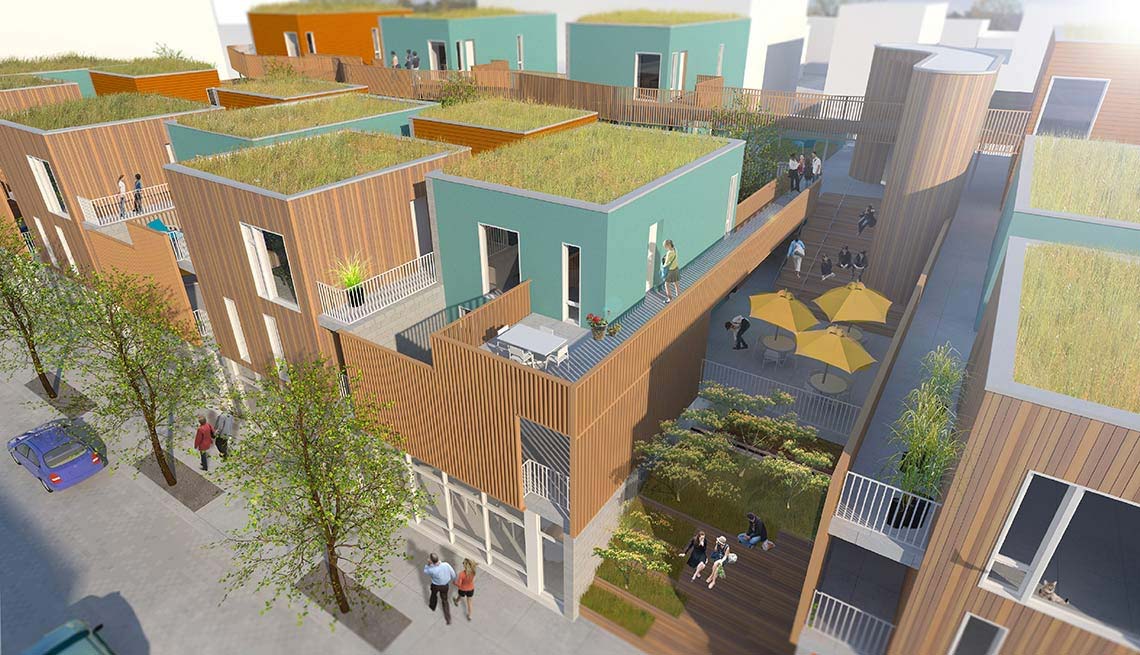The Future of Housing
Homes and communities must become 'all-age' friendly
En español | A recent report by AARP Foundation and the Harvard Joint Center of Housing Studies found that nearly 20 million older adults live in unaffordable and unsafe housing. Twenty million households are paying over 30 percent of their income on housing, and almost 10 million households are paying over 50 percent. Plus, only 1 percent of all housing stock in the U.S. has the recommended universal design features — such as a step-free entry, multiple countertop heights, wide doorways, lever faucets and a curbless shower with a handheld adjustable showerhead. With 10,000 people turning 65 each day for the next 15 years, the situation is only going to get worse unless we do something to change it.
That's why, last month, AARP and AARP Foundation joined with Atlantic LIVE and the U.S. Department of Housing and Urban Development to convene a two-day summit on the future of housing. We brought together experts from a wide array of industries to address the challenges of creating homes and neighborhoods that meet the needs of people of all ages.
Be an E-Activist. Sign up for the AARP Advocate e-newsletter »
Nearly 9 of 10 people age 65 and older want to remain in their homes and communities as they get older. But far too often, their communities and their homes don't fit them anymore. Instead of being a place that makes them feel safe, secure and comfortable, just the opposite happens. Their homes and communities become barriers to remaining independent and engaged in society. There is a lack of housing with basic features that support aging. There are not enough options that would allow them to downsize but stay in their neighborhoods. And there is a lack of affordable housing as well as access to services that can help a community serve people of all ages, incomes and abilities.
This often forces people into making changes they don't want to make. We hear this all the time — "I'm getting older, and it's harder for me to get up and down the stairs. I guess I'll have to move. I hate to because I love my neighborhood. All my friends are here. But what choice do I have?"
We want people to understand that they do have a choice. Instead of blaming our age, maybe we just need to change the environment. Retrofit our houses to make them work for us. Take steps to make our communities more age-friendly — not "old-age friendly" but "all-age friendly."
Take a Stand. Get the latest information about who has a plan for Social Security »
One of our goals at AARP is to spark new solutions that make communities more livable — not just for older people, but for people of all ages. We convened the Future of Housing summit to spark those new solutions. And to take it a step further, we have also announced two competitions designed to seek out promising ideas and create new opportunities to turn those ideas into action. The first is Re-defining Home: Home Today, Home Tomorrow. With support from AARP Foundation, AARP, Wells Fargo Housing Foundation and Home Matters, this competition challenges the housing industry to find the most innovative, cost-effective solutions that will allow people to stay in their homes throughout their lives. Once we have the winning design, we'll use it to rebuild a home for a family to live in as they age.
The second competition is the 2016 Aging in Place $50K Challenge. We will award $50,000 to the competitor with the most innovative solution that helps low-income people 50 and older continue to age in their homes.
I believe that technology, innovation and collaboration can help us create a future of housing that will bring us new choices and new ways to live engaged, purposeful and meaningful lives as we age. But we need a new focus, not just on senior housing, but housing for an entire lifetime, housing for all generations and all income levels that allows us to live comfortably in good health, go where we want to go safely and remain active and engaged in society. And we must all work together to achieve it.
Jo Ann Jenkins is CEO of AARP.


